In the
Minchiate Etruria edition
the Empress is featured as a male character, who wears a beard; this is clearly a consequence of the change occurred in Bologna, by which all the subjects from no.II (
the Popess) to V (
the Pope), were turned into four
Moors
of equal rank, see also
Regional Tarots,
part 1.
In fact,
the Empress and
the Emperor of the
Minchiate al Leone have rather tanned faces, compared to the aforesaid
Grand-duke, as
the Moors use to have in Bologna tarots during the 18th and 19th centuries.
The aforesaid change of
the Popess (female) into
the Grand-duke
(male) follows the same principle.
Furthermore, all three personages hold an identical globe and sceptre, suggesting that also their rank is the same.
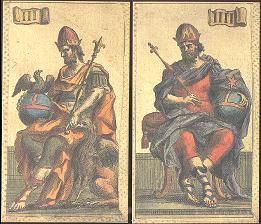

E (left) and L - the Empress and the Emperor
The Cardinal Virtues are grouped together (VI, VII and VIII); strangely, the fourth Virtue, i.e. Prudence (shown further in the page), usually ignored by other tarots, is included among the Minchiate's featured subjects, but wrongly listed among the three Theological Virtues: Hope (XVI), Faith (XVIII) and Charity (XVIIII), therefore
quite over-ranked compared to the Cardinal ones.
The Theological Virtues had been featured only once, in a very early hand-painted
tarot, i.e. the 15th century deck, now known as "Cary-Yale Visconti"
(see the Visconti Tarots).
E - Fortitude |
 |
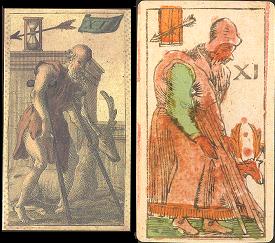 |
The eleventh subject is the Hermit, though still evidently featured according to his old name, Time. An old man walks with crutches, while an hour-glass crossed by an arrow (a highly specific detail, found in both editions) reminds us that time flies.
The Wheel of Fortune, with four personages, is followed by the Chariot, so that
all the trumps up to the Tower (XV) mismatch the classic ranking, except two subjects: the Hanged Man and Death (XII and XIII, respectively).
E (left) and L - the Hermit |
The former is featured with bags of gold or coins in both hands, exactly as
the personage in the late 15th century Tarot of Charles VI, belonging
to the pattern group from Ferrara (Dummett's C), in which this subject was
probably still called the Traitor.
The coins are likely the reward received by the man for his betrayal, which now, by trick of fate, increase his
weight, thus augment his suffering. Note how in the Minchiate al Leone edition the bags of gold were stylized into the shape of two spheres. |
|
the Hanged Man: on the left, Tarot of Charles VI (Ferrara, 1460-80);
center: Minchiate Etruria; right: Minchiate al Leone |

E (left) and L - the Tower |
Also no. XV, the Tower, still contains a reminiscence
of the obsolete subject, Lightning: two rather worried figures hurriedly
exit a building (maybe a tower?) that has just been set on fire by a thunderbolt.
Numbers XX to XIII represent the four Elements,
once considered the principles of all things in nature: Fire, Water, Earth
and Air, never found in any other standard tarot.
|
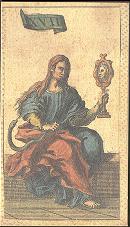
E - the misplaced
Prudence |
The twelve classic zodiac signs are featured immediately after, from XXIIII
through XXXV; they start with
Libra and end with
Gemini, in an
apparently random order, thus mismatching the traditional sequence.
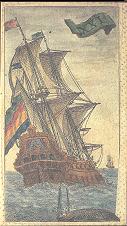
E - Water, one of
the four Elements |
Five more trumps, referred to as Arie ("Airs"),
have no number, but their sequence is standard: they match the last five subjects of standard tarots, i.e.
the three cosmological ones, the World and Judgement; the last two,
as previously said, are in reversed order. They all have more glamorous backgrounds than the rest of the trumps, either in different colours (Minchiate Etruria) or in one colour only (Minchiate al Leone).
The three cosmological trumps feature unusual subjects. In the Star, a male figure on horseback holds a cup; he is probably using the starry sky for orienting his route. His rich clothes and a small crown worn over a turban suggest his high rank, maybe even one of the three Magi, said to have reached Christ's birthplace guided by a star. |
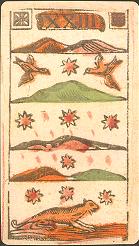
L - Air's curious allegory |
The World is featured in the typical style of Ferrara, i.e. with
a heavenly figure balancing over the world's globe, surrounded by
puffing cherubs (a similar interpretation is also given in the
Tarot de Paris and in the
Flemish tarot).
E (above) and L (below) - the five Airs: the Star, the Moon, the Sun,
the World and Judgement
Interestingly, for illustrating the World's setting each manufacturer chose the skyline of his own city: in the Minchiate Etruria the large dome of Florence's cathedral is easily recognizable, while the crucial detail in the Minchiate al Leone is less easily detectable, and consists of the exaggerately leaning tower.
go to part 2
OTHER GALLERIES




















or back to

INTRODUCTION
AND HISTORY
|

MULTI-LANGUAGE
GLOSSARY |

THE FOOL &
THE JOKER |

INDEX
TABLE |

REGIONAL
GAMES |

PLAYING CARD
LINKS |